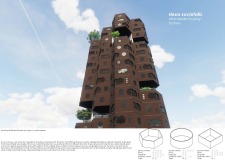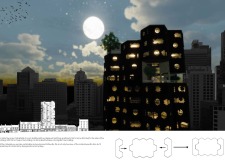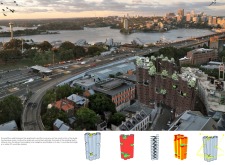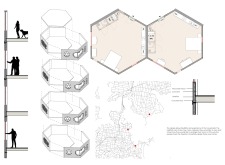5 key facts about this project
At its core, Hexa Societatis aims to provide flexible living environments that cater to diverse family structures and lifestyles. The architecture is characterized by modular housing units that can be easily reconfigured or expanded, allowing residents to personalize their living spaces according to individual needs. This adaptability not only enhances the functionality of the housing but also fosters a sense of ownership and investment in the community.
The material selection within the project reflects a commitment to sustainability, with a focus on eco-friendly options such as recycled wood and concrete. These materials are integral to the structural integrity of the units, ensuring durability while minimizing the environmental impact associated with more traditional building materials. Additionally, the use of insulation material further promotes energy efficiency, a key consideration in modern architectural design.
Unique design features are evident in the project's facade, which marries aesthetics with sustainability. The integration of hexagonal openings allows for natural light to permeate the interiors while facilitating passive ventilation. This design choice not only enhances the quality of living spaces but also encourages residents to create a connection with the outdoors, contributing to mental well-being in densely populated urban settings.
The spatial configuration of Hexa Societatis encourages community engagement through designated communal areas that serve as gathering places. These spaces are thoughtfully positioned to facilitate social interactions among residents, promoting a sense of belonging and community cohesion. In doing so, the project responds to current societal needs by fostering environments where residents can share resources and connect with each other.
One particularly noteworthy aspect of this project is the emphasis on adaptability. Each housing unit is designed to allow homeowners to expand their spaces seamlessly, adding hexagonal modules as their needs evolve over time. This approach not only accommodates growing families but also reduces the need for extensive renovations that contribute to waste and resource consumption.
In summary, the Hexa Societatis project represents a comprehensive response to the challenges of urban housing today. Its modular design, sustainable material usage, and community-focused features position it as a relevant model for contemporary architecture. Readers are encouraged to delve deeper into the intricacies of this project by exploring its architectural plans, sections, and design elements to gain a fuller understanding of its innovative approach to housing solutions. This exploration will enrich one’s appreciation for how architecture can thoughtfully address the complexities of urban living.


























